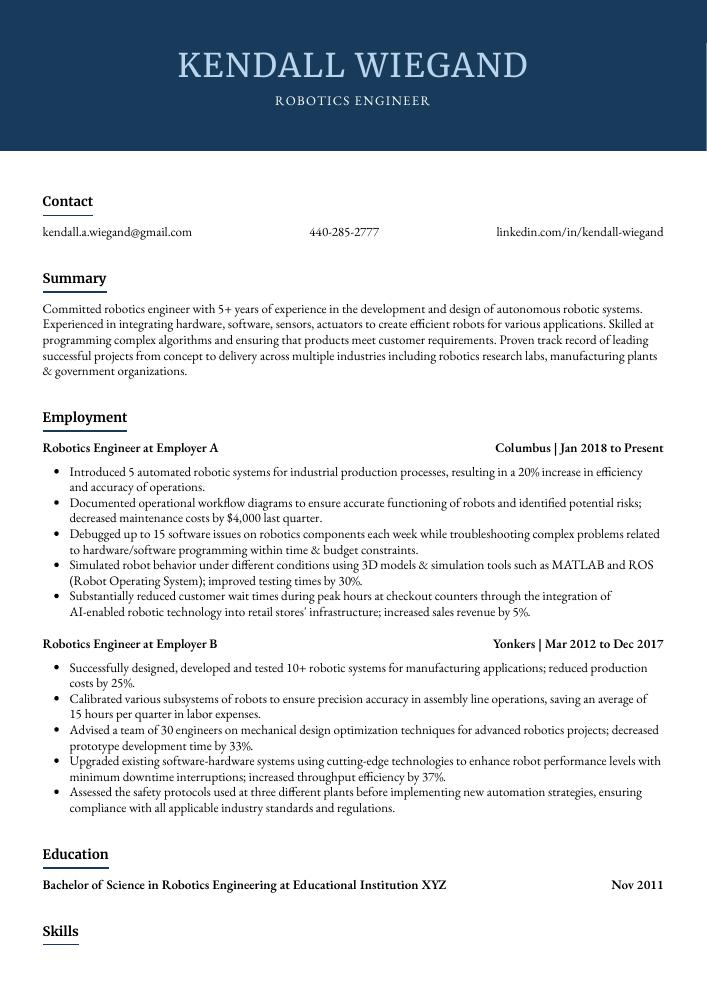Robotics Engineer Resume Guide
Robotics Engineers design, build and maintain robots. They use computer programming to create robots that can interact with their environment, as well as using sensors and mechanical parts to make the robot move in a certain way. Robotics Engineers also work on developing new robotic technologies for various industries such as manufacturing, healthcare, military and aerospace.
Robotics engineering is your passion, and you know that no one can build a robot like you. To let hiring managers know of your expertise in this field, you need to write an eye-catching resume.
This guide will walk you through the entire process of creating a top-notch resume. We first show you a complete example and then break down what each resume section should look like.
Table of Contents
The guide is divided into sections for your convenience. You can read it from beginning to end or use the table of contents below to jump to a specific part.
Robotics Engineer Resume Sample
Kendall Wiegand
Robotics Engineer
kendall.a.wiegand@gmail.com
440-285-2777
linkedin.com/in/kendall-wiegand
Summary
Committed robotics engineer with 5+ years of experience in the development and design of autonomous robotic systems. Experienced in integrating hardware, software, sensors, actuators to create efficient robots for various applications. Skilled at programming complex algorithms and ensuring that products meet customer requirements. Proven track record of leading successful projects from concept to delivery across multiple industries including robotics research labs, manufacturing plants & government organizations.
Experience
Robotics Engineer, Employer A
Columbus, Jan 2018 – Present
- Introduced 5 automated robotic systems for industrial production processes, resulting in a 20% increase in efficiency and accuracy of operations.
- Documented operational workflow diagrams to ensure accurate functioning of robots and identified potential risks; decreased maintenance costs by $4,000 last quarter.
- Debugged up to 15 software issues on robotics components each week while troubleshooting complex problems related to hardware/software programming within time & budget constraints.
- Simulated robot behavior under different conditions using 3D models & simulation tools such as MATLAB and ROS (Robot Operating System); improved testing times by 30%.
- Substantially reduced customer wait times during peak hours at checkout counters through the integration of AI-enabled robotic technology into retail stores’ infrastructure; increased sales revenue by 5%.
Robotics Engineer, Employer B
Yonkers, Mar 2012 – Dec 2017
- Successfully designed, developed and tested 10+ robotic systems for manufacturing applications; reduced production costs by 25%.
- Calibrated various subsystems of robots to ensure precision accuracy in assembly line operations, saving an average of 15 hours per quarter in labor expenses.
- Advised a team of 30 engineers on mechanical design optimization techniques for advanced robotics projects; decreased prototype development time by 33%.
- Upgraded existing software-hardware systems using cutting-edge technologies to enhance robot performance levels with minimum downtime interruptions; increased throughput efficiency by 37%.
- Assessed the safety protocols used at three different plants before implementing new automation strategies, ensuring compliance with all applicable industry standards and regulations.
Skills
- MATLAB
- Robotics
- C++
- Python
- SOLIDWORKS
- C
- Engineering
- Java
- Programming
Education
Bachelor of Science in Robotics Engineering
Educational Institution XYZ
Nov 2011
Certifications
Certified Robotics Engineer
Robotics and Automation Society
May 2017
1. Summary / Objective
Your resume summary should be a concise overview of your robotics engineering experience and qualifications. It should highlight the most impressive aspects of your background, such as any awards you have won or patents you hold, as well as the programming languages and frameworks that you are proficient in. The summary is also where you can mention how many years of experience you have in this field, what kind of projects/products you’ve worked on before, and how successful they were. This will give employers an idea about why they should hire someone with your skillset for their team.
Below are some resume summary examples:
Well-rounded robotics engineer with a passion for designing, building and optimizing autonomous systems. Proven track record of developing innovative robotic solutions to solve complex problems using C++, Python and ROS. Experienced in leading cross-functional teams from concept to product launch while ensuring quality standards are met throughout the development process. Seeking a position at ABC Robotics where I can use my technical experience and leadership capabilities to drive success.
Diligent robotics engineer with 5+ years of experience in developing and testing robots for various applications. Proven track record of improving safety and efficiency by designing, assembling, programming, debugging, and deploying robotic systems. At XYZ Robotics Company developed a robot capable of autonomously navigating hazardous environments without human interaction or input. Highly skilled at working on multiple projects simultaneously while meeting deadlines efficiently.
Amicable robotics engineer with 5+ years of experience developing, testing and troubleshooting automated robotic systems. At XYZ, designed high-functioning robots for medical applications that were 50% faster than existing models. Experienced in all stages of the development process from conceptualization to deployment and maintenance. Skilled at programming in C++, Python, Java and MATLAB as well as working with various robotics platforms such as Arduino and Raspberry Pi.
Detail-oriented robotics engineer with 5+ years of experience in the design, development and deployment of robotic systems. Skilled in working with a variety of programming languages such as Python and C++ to develop control algorithms for autonomous robots. At XYZ Robotics Company, developed software that enabled robots to autonomously navigate through a warehouse environment. Received “Outstanding Contribution” award from company CEO for successful project completion.
Accomplished robotics engineer with 10+ years of experience in the design and implementation of robotic production systems. Proficient in programming, electrical engineering principles, and machine learning algorithms. At XYZ Robotics, developed a custom vision-based robot that improved production speed by 18%. Seeking to join ABC Technologies as a robotics engineer to develop innovative solutions using cutting-edge technologies.
Determined robotics engineer with 5+ years of experience building advanced robotic systems for industrial and consumer applications. Expert in developing innovative solutions to complex problems, as evidenced by an autonomous robot that successfully navigated a series of obstacles. Seeking to join ABC Tech where I can apply my knowledge and skills toward the development of cutting-edge robotics technology.
Energetic robotics engineer with 5+ years of experience developing and integrating advanced robotic systems for industrial applications. Proven track record in designing, building, testing, and troubleshooting robotics-based solutions to improve machine performance. Recent success includes leading a team that reduced downtime by 46% thanks to the implementation of an efficient automation system.
Seasoned robotics engineer with 8+ years of experience developing and deploying a range of autonomous robotic systems for industrial applications. Skilled in designing, testing, troubleshooting, and maintaining robots using industry-standard programming languages. Seeking to join ABC Robotics as the lead robotics engineer to create innovative solutions that enhance production efficiency.
2. Experience / Employment
In the experience section, you should list your employment history in reverse chronological order. Stick to bullet points when writing this section; it makes the information easier for the reader to digest quickly.
When stating what you did, provide detail and explain any quantifiable results that were achieved. For example, instead of saying “Designed robotic systems,” you could say, “Developed three autonomous robots with advanced AI capabilities which reduced production costs by 35%.”
To write effective bullet points, begin with a strong verb or adverb. Industry specific verbs to use are:
- Designed
- Programmed
- Constructed
- Assembled
- Tested
- Debugged
- Analyzed
- Simulated
- Operated
- Troubleshot
- Calibrated
- Documented
- Implemented
- Monitored
- Upgraded
Other general verbs you can use are:
- Achieved
- Advised
- Assessed
- Compiled
- Coordinated
- Demonstrated
- Developed
- Expedited
- Facilitated
- Formulated
- Improved
- Introduced
- Mentored
- Optimized
- Participated
- Prepared
- Presented
- Reduced
- Reorganized
- Represented
- Revised
- Spearheaded
- Streamlined
- Structured
- Utilized
Below are some example bullet points:
- Designed and developed robotic systems for a wide range of applications, including fabrication and assembly, resulting in improved workplace automation by 50%.
- Spearheaded the rapid prototyping and testing process of six robot prototypes to assess their performance; successfully negotiated cost reduction with suppliers to cut expenses by 10%.
- Revised existing software codes used in robots’ programming and navigation systems while ensuring full compliance with safety regulations; decreased debugging time from 12 hours to 8 hours on average.
- Efficiently coordinated cross-functional teams comprising mechanical engineers, electricians & technicians during installation projects at customer sites; completed 3 major assignments ahead of schedule within budget limits.
- Formulated innovative artificial intelligence algorithms that enabled machines to autonomously complete complex tasks without human intervention; increased production rate by 30% compared to manual operations performed prior implementation.
- Optimized robotic systems for enhanced efficiency, decreasing energy consumption by 45% and total production costs by $2.3 million over the past year.
- Structured efficient robotic control algorithms to automate manufacturing tasks; improved precision of end products significantly while reducing process time by 30%.
- Constructed 5 full-scale robots from scratch using a variety of fabrication techniques including 3D printing, welding and machining; reduced construction cycle times from 9 weeks to 6 weeks on average per robot unit.
- Proficiently programmed high-level languages such as C++ & Java into robotic arms to enable independent operation with minimal human supervision; increased accuracy levels up to 99% within 2 months of development completion cycles.
- Developed complex sensors network structures in order to increase agility of automated assembly lines, resulting in decreased downtime periods from 1 hour/day down to 15 minutes/day on average.
- Analyzed complex robotics engineering problems, troubleshooting issues found in over 500 robots and finding solutions that improved overall efficiency by 27%.
- Reduced downtime on production lines significantly through proactive maintenance checks of robotic systems; achieved an average 25% decrease in machine stoppage time per month.
- Compiled detailed technical reports for senior management summarizing the performance metrics of all robots within the factory, including energy usage levels and error codes encountered during operation.
- Troubleshot software-related bugs with a team of engineers to ensure seamless integration between automated machines and other industrial equipment; cut debugging times by 45 hours per week compared to previous year’s figures.
- Actively investigated potential areas where automation could be utilized throughout the facility, resulting in increased labor productivity across multiple departments by $100K annually.
- Operated and maintained robotic systems in a manufacturing environment, ensuring that all safety protocols were met and production goals exceeded; decreased average downtime by 20%.
- Utilized advanced programming skills to create automated solutions for product assembly processes, resulting in an increase of productivity output by 30%.
- Prepared user documentation including instructions on how to use the robots, as well as maintenance procedures; trained 15+ colleagues on robotics system operation within 4 months.
- Accurately monitored robot performance metrics such as speed and accuracy during daily operations; implemented improvements that increased operational efficiency by 25% over 6 months period.
- Tested robotic components regularly to ensure maximum reliability throughout its life cycle; successfully identified potential defects before they caused any major issues or downtime which saved $10K per month in repairs costs.
- Programmed and maintained robotic systems for over 20 industrial, commercial and research projects; increased overall automation efficiency by 35%.
- Mentored junior engineers in the development of robotics technology through hands-on training and workshops; reduced onboarding time of new hires by 50%.
- Thoroughly tested all programs written to ensure accuracy and reliability prior to implementation, leading to a reduction in defects from 10% to 4%.
- Implemented innovative solutions that improved safety protocols while operating robots on production lines with an 85% success rate.
- Streamlined processes related to robot programming using cutting-edge software tools, resulting in a 25% decrease in labor costs associated with maintenance & repairs per month.
- Participated in the development of over 30 robotic systems from design to installation, reducing production time by 20%.
- Assembled complex mechanical components and electric/electronic subassemblies for robots; tested circuitry, servomotors and sensors prior to integration into automated system designs.
- Facilitated extensive research on robotics applications in industrial automation processes; developed algorithms that improved accuracy of machine learning models by 15%.
- Independently troubleshot software coding issues within robot-controlled systems while debugging embedded controllers; reduced downtime significantly during testing cycles with a resolution rate of 95%+.
- Monitored all installed robotic equipment performance data remotely using advanced analytics tools and identified potential malfunctions before they occurred, avoiding costly repairs or replacements expenses altogether.
- Reorganized robotics assembly process, reducing production time by 25% and increasing efficiency in the lab.
- Achieved 6 successful launches of cutting-edge robotic devices that reduced operational costs for clients by $4,000 each.
- Resourcefully identified technical issues with robots using troubleshooting techniques and overhauled components to restore functionality within hours.
- Presented project demonstrations to potential investors at key industry events, resulting in over $25 million worth of investments for the company’s robotics division over 3 years span.
- Represented company on international forums as a leading expert in robotics engineering; published 10+ research papers and articles on emerging technology trends across all major journals worldwide.
- Expedited the development of robotic systems, completing 6 projects ahead of schedule and within budget.
- Improved the accuracy & efficiency of existing robots by 30% through innovative programming techniques; reduced production costs by $50K in total.
- Demonstrated strong knowledge and skill when designing robotics control systems, as well as analyzing data collected from sensors & actuators to identify system defects swiftly.
- Coordinated with a cross-functional team comprising software engineers, hardware designers & technicians to develop 10+ robot prototypes for various applications in under 3 months on average per project cycle.
- Competently identified potential risks associated with embedded technologies used in robotic systems and proposed solutions that eliminated safety hazards for users during operation stage effectively.
3. Skills
Skill requirements will differ from employer to employer – this can easily be determined via the job advert. Organization ABC may be looking for someone with experience in machine learning, while Organization XYZ may require knowledge of embedded systems.
To ensure your resume stands out from the crowd and is not filtered out by applicant tracking systems (which are computer programs that scan resumes for certain keywords), you should tailor the skills section to each job posting. This means listing only those skills relevant to that particular position.
You can elaborate on these further in other sections such as the summary or work experience, providing evidence of how you have used them successfully in past positions.
Below is a list of common skills & terms:
- 3D Printing
- Algorithms
- Ansys
- Arduino
- Artificial Intelligence
- AutoCAD
- Automation
- Automotive
- C
- C#
- C++
- CAD
- Computer Aided Design
- Computer Vision
- Continuous Improvement
- Control Systems Design
- Data Analysis
- Electrical Engineering
- Electronics
- Embedded Systems
- Engineering
- Finite Element Analysis
- Git
- HTML
- Java
- JavaScript
- LaTeX
- LabVIEW
- Lean Manufacturing
- Linux
- MATLAB
- Machine Learning
- Machine Vision
- Machining
- Manufacturing
- Manufacturing Engineering
- Mechanical Engineering
- Mechatronics
- Microcontrollers
- OpenCV
- PLC
- Product Development
- Programming
- Python
- ROS
- Robot Programming
- Robotics
- SOLIDWORKS
- SQL
- Sensors
- Simulations
- Simulink
- Software Development
- Team Leadership
- Teamwork
- Testing
- Time Management
- Troubleshooting
- Windows
4. Education
Including an education section on your resume depends on how far along you are in your career. If you have just graduated and have no prior work experience, mention your educational background below the resume objective. However, if you already have years of robotics engineering experience under your belt, an education section may not be necessary at all.
If including an education section is appropriate for this job application, try to focus on courses related to robotics engineering that demonstrate a strong knowledge base in the field.
Bachelor of Science in Robotics Engineering
Educational Institution XYZ
Nov 2011
5. Certifications
Certifications are a great way to demonstrate your knowledge and proficiency in a certain field. They are especially important if the job you’re applying for requires specific skills or qualifications that can be verified by an accredited organization.
When including certifications on your resume, make sure to include any relevant details such as when it was obtained and from what institution. This will help employers understand how up-to-date your certification is, which could give you an edge over other applicants who may not have one at all.
Certified Robotics Engineer
Robotics and Automation Society
May 2017
6. Contact Info
Your name should be the first thing a reader sees when viewing your resume, so ensure its positioning is prominent. Your phone number should be written in the most commonly used format in your country/city/state, and your email address should be professional.
You can also choose to include a link to your LinkedIn profile, personal website, or other online platforms relevant to your industry.
Finally, name your resume file appropriately to help hiring managers; for Kendall Wiegand, this would be Kendall-Wiegand-resume.pdf or Kendall-Wiegand-resume.docx.
7. Cover Letter
Including a cover letter with your job application is highly recommended. It’s a great way to provide more detail about yourself and why you’re the perfect fit for the role.
Cover letters should be between 2-4 paragraphs long and include relevant information that isn’t already mentioned in your resume. They are an excellent opportunity to showcase your personality, highlight key points from your experience, explain any gaps in employment or education, and demonstrate enthusiasm for the company or position you’re applying for.
Below is an example cover letter:
Dear Gilbert,
I am writing to apply for the Robotics Engineer position at your company. As a highly skilled and experienced engineer with experience in designing, developing, and testing robotic systems, I believe I would be a valuable asset to your team.
My experience includes working on projects involving the development of autonomous robots for use in industrial and commercial applications. I have also worked on projects involving the development of control systems for robotic devices. In addition, I have experience in programming robotic devices using various programming languages. My skills and experience would enable me to contribute to the success of your company by helping you develop innovative new products that meet the needs of your customers.
I am confident that I can be an asset to your company and look forward to discussing how my skills and experience can benefit your organization. If you have any questions, please do not hesitate to contact me at [phone number] or [email address]. Thank you for your time and consideration, and I look forward to hearing from you soon.
Sincerely,
Kendall
Robotics Engineer Resume Templates
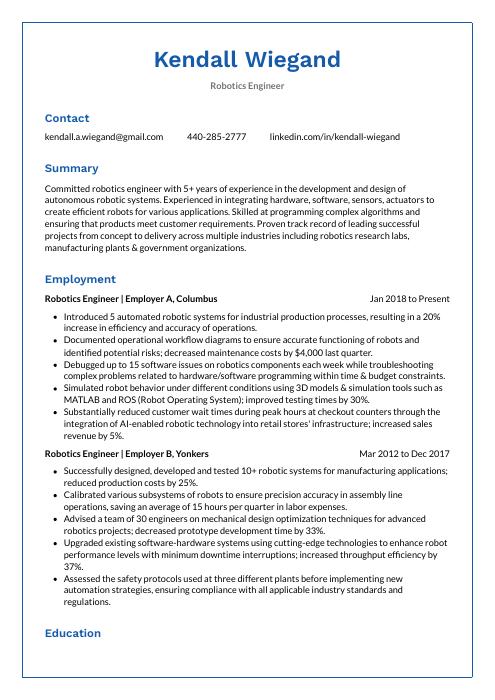 Markhor
Markhor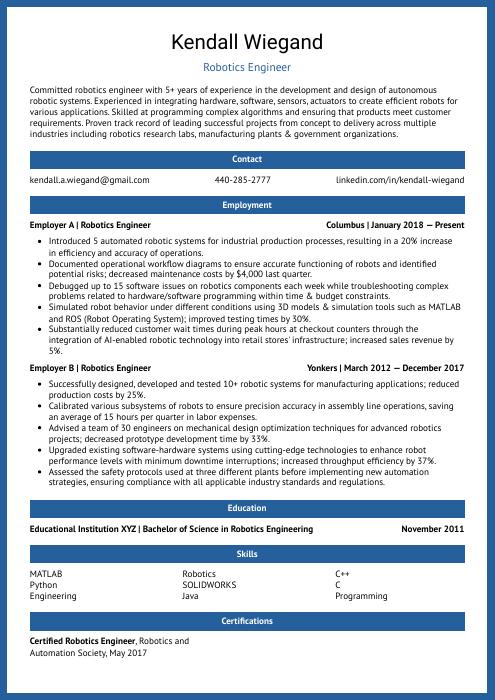 Ocelot
Ocelot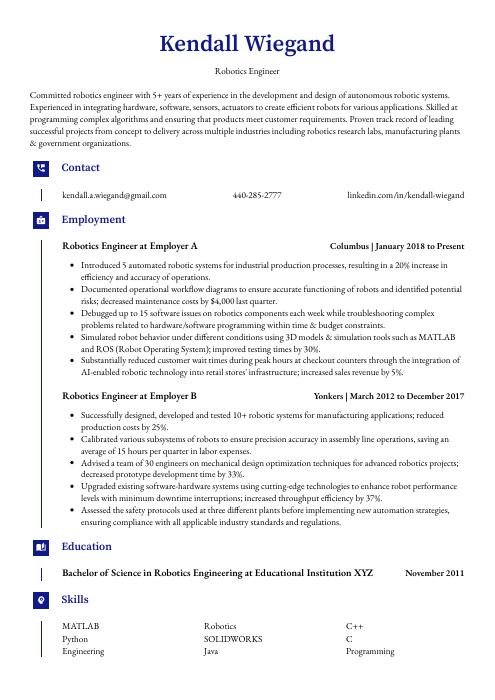 Gharial
Gharial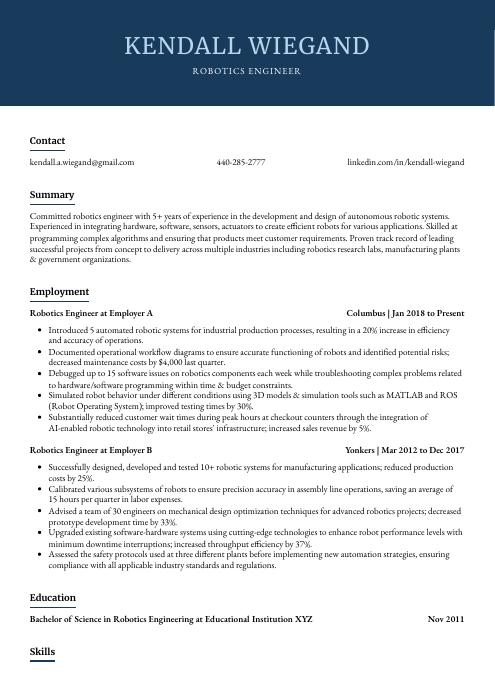 Bonobo
Bonobo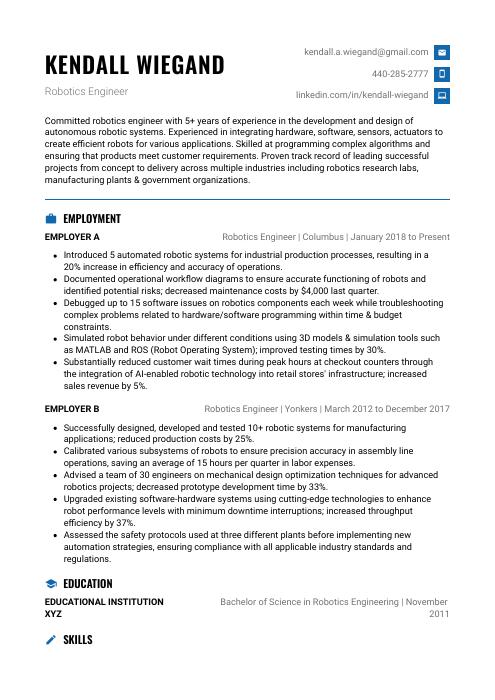 Echidna
Echidna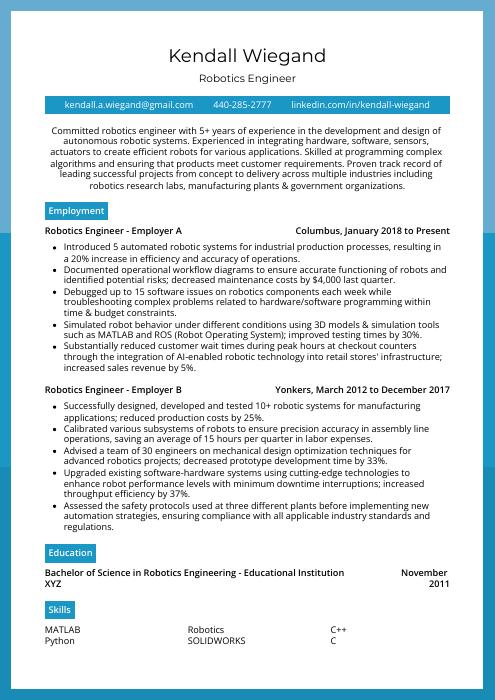 Rhea
Rhea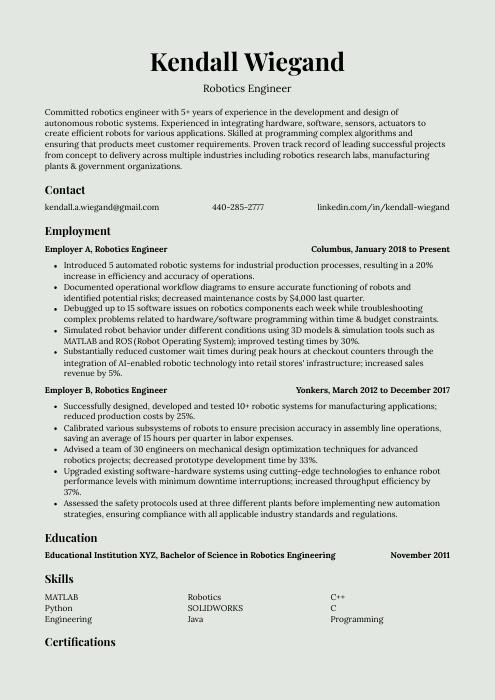 Saola
Saola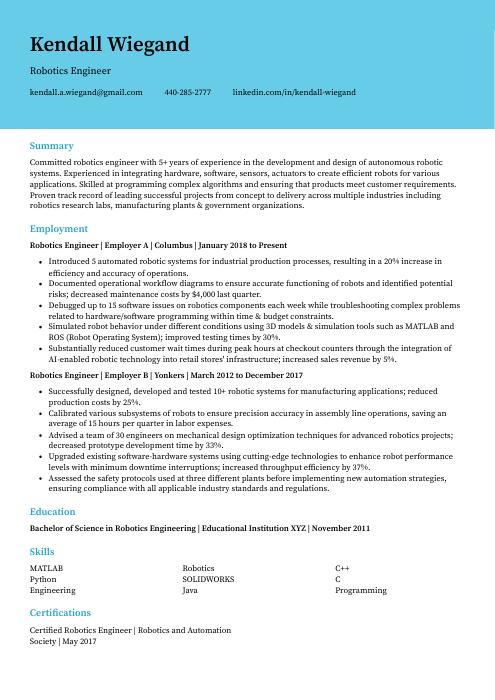 Dugong
Dugong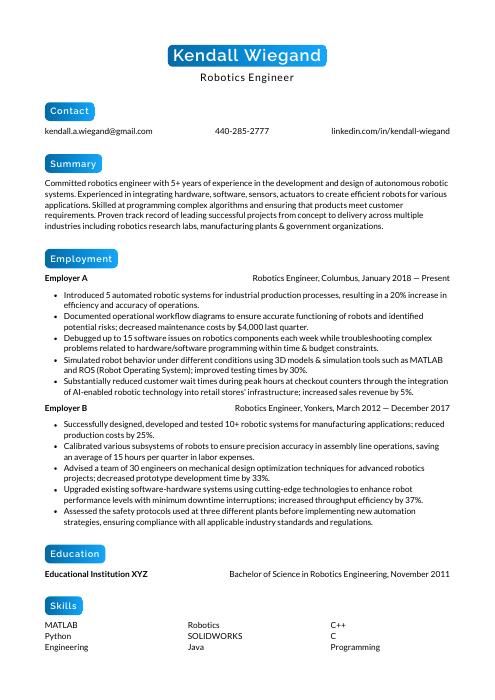 Kinkajou
Kinkajou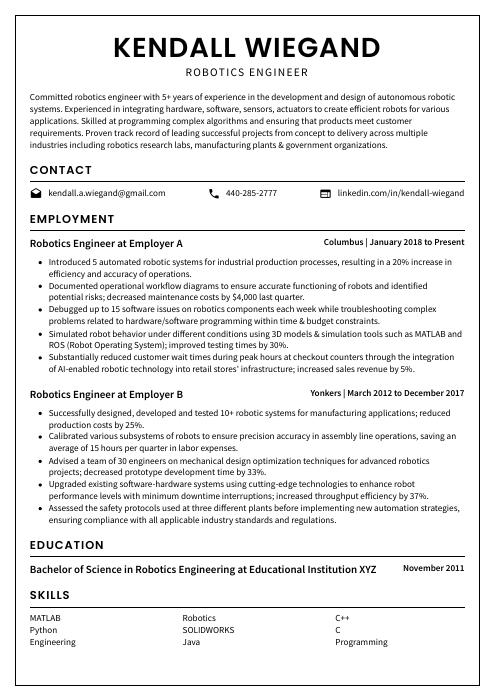 Cormorant
Cormorant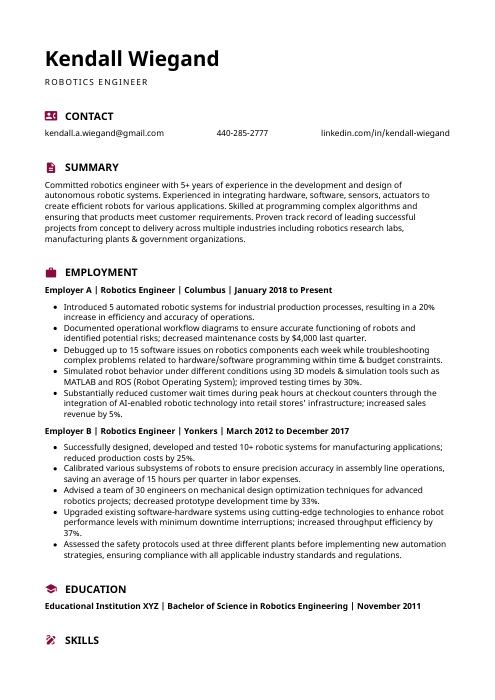 Hoopoe
Hoopoe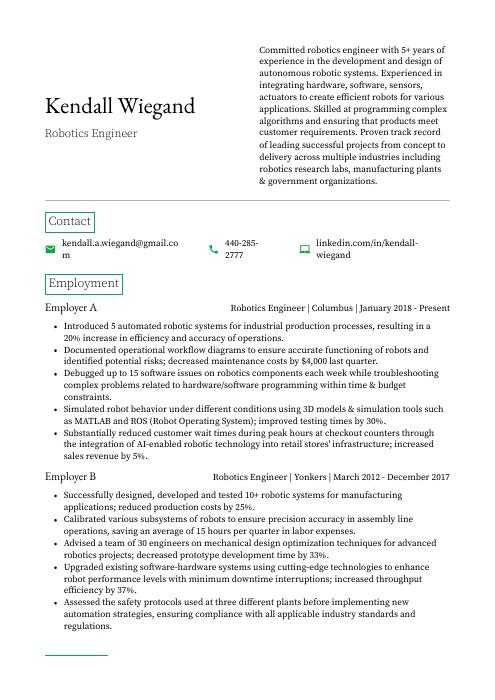 Quokka
Quokka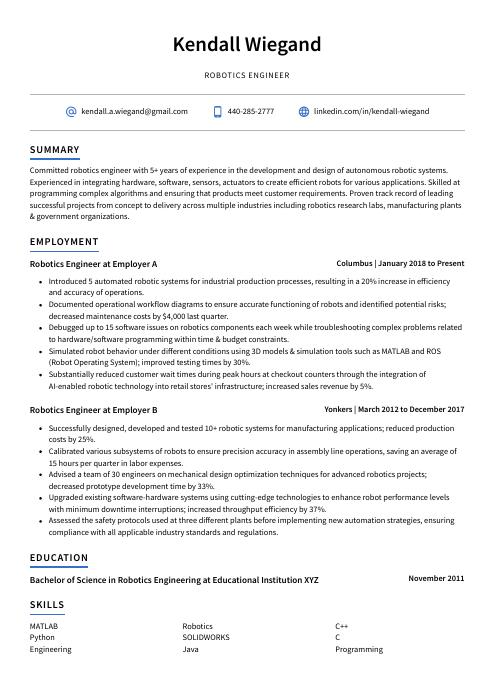 Axolotl
Axolotl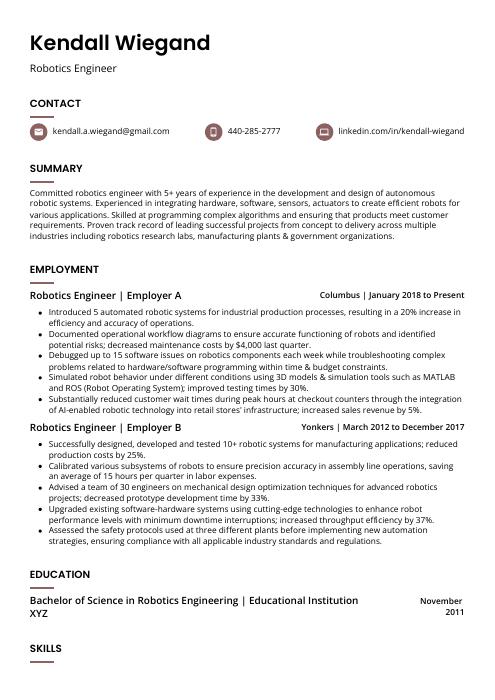 Fossa
Fossa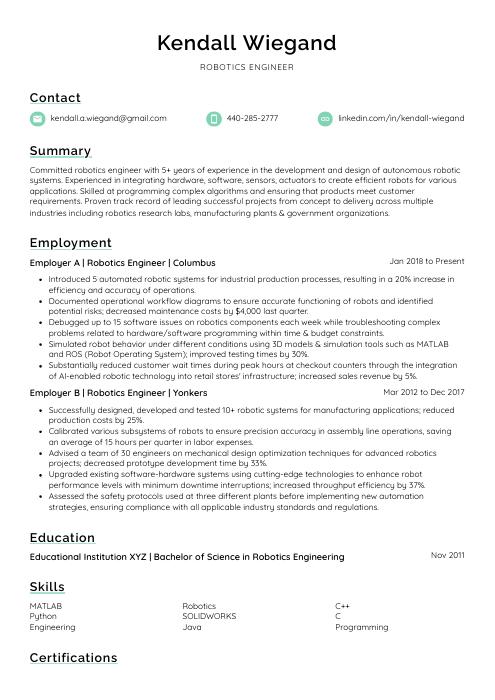 Lorikeet
Lorikeet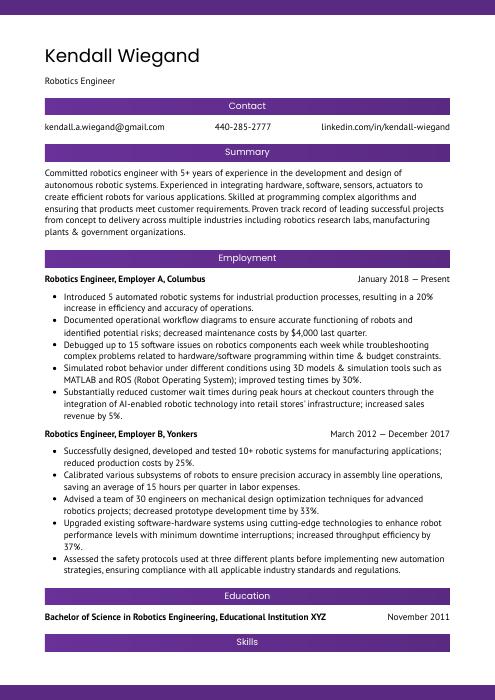 Jerboa
Jerboa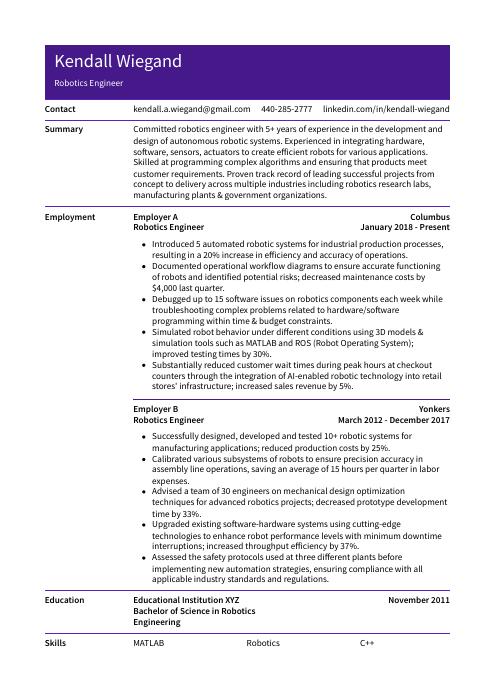 Pika
Pika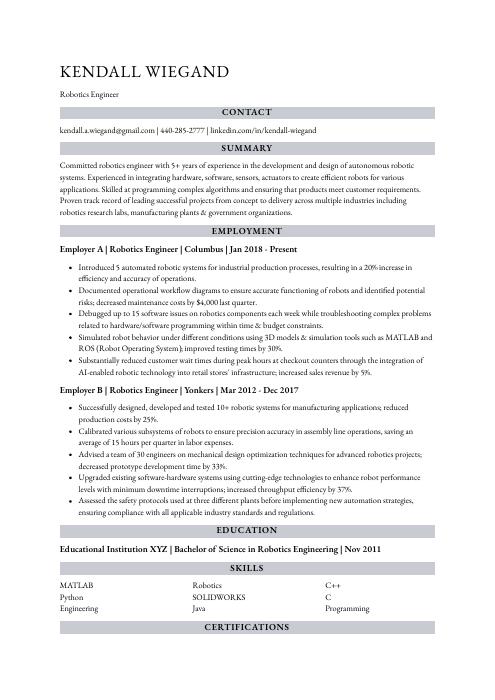 Numbat
Numbat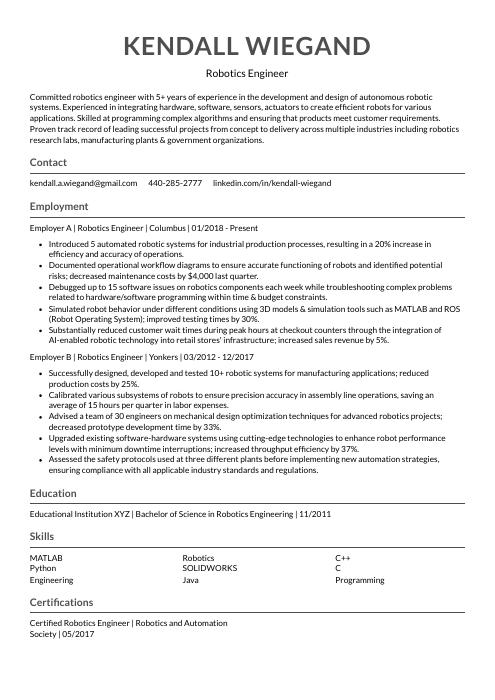 Indri
Indri Rezjumei
Rezjumei
